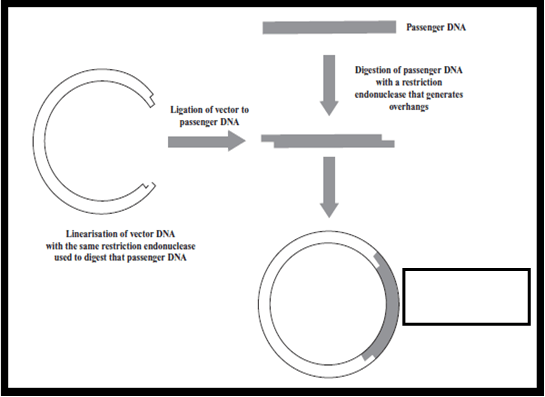This set of Basic Biotechnology Multiple Choice Questions & Answers (MCQs) focuses on “Genetics – The Polymerase Chain Reaction and DNA Sequencing”.
1. Vector DNA and passenger DNA join together to form ‘X’. What is ‘X’?

a) Recombinant DNA
b) Recombinant protein
c) Recombinant enzyme
d) Recombinant RNA
View Answer
Explanation: Vector DNA is linearized using a restriction enzyme. The same enzyme is used to cut the passenger DNA. Both of them are joined together by DNA ligase.
2. What are used to cut DNA at specific sites?
a) Restriction enzymes
b) DNA ligase
c) DNA polymerase
d) Lipases
View Answer
Explanation: Restriction enzymes are used to cut DNA at specific sites. These are also called as molecular scissors. Restriction enzymes are further classified as Restriction endonucleases and exonucleases.
3. PCR stands for ___________
a) Polymer chained reaction
b) Polynucleotide chain reactants
c) Polymer chain reactants
d) Polymerase chain reaction
View Answer
Explanation: PCR is polymerase chain reaction. Enzyme DNA Polymerase is used here. DNA polymerase is not thermostable.
4. Taq DNA Polymerase is obtained from ____________
a) Thermus aquaticus
b) Thermal aqua
c) Thermite aqua
d) Thermal aquaticus
View Answer
Explanation: Taq polymerase is a thermostable DNA polymerase. It is named after thermophilic bacterium Thermus aquaticus, from which it is isolated. It is frequently used in PCR.
5. Life forms containing foreign DNA are termed as ________
a) Transgenic animals
b) Mutants
c) Giants
d) Dwarfs
View Answer
Explanation: Life forms containing foreign DNA are called transgenic. There are no limits to the range of organisms produced this way. They contain the foreign gene.
6. Restriction enzyme Hind is isolated from _________
a) Haemophilus influenzae
b) Herophilus influence
c) Herophilus influenzae
d) Hemophilic influenzae
View Answer
Explanation: Restriction enzyme Hind is isolated from Haemophilus influenzae. They are named according to the species from which they are first isolated. Restriction enzymes are molecular scissors.
7. Which novel method of ensuring DNA uptake into cells involves creating transient pores in the cell membrane by applying an electric field?
a) Gel Electrophoresis
b) Biolistic
c) Electroporation
d) PCR
View Answer
Explanation: Electroporation is a novel method of ensuring DNA uptake into cells. It involves creating transient pores in the cell membrane. This is done by applying an electric field.
8. Which technique allows selective amplification of any fragment of DNA if DNA sequences flanking the fragment are known?
a) PCR
b) Gel electrophoresis
c) Biolistic
d) Gene gun
View Answer
Explanation: PCR stands for polymerase chain reaction. It allows selective amplification of any fragment of DNA. It can be done if DNA sequences flanking the fragments are known.
9. Who invented PCR?
a) Kary Mullis
b) Charles Darwin
c) Gregor Mendel
d) Aristotle
View Answer
Explanation: PCR was invented by Kary Mullis. He got Nobel Prize in Chemistry. He shared the prize in the year 1993.
10. DNA has which sugar in its structure?
a) Deoxyribose sugar
b) Thymidine
c) Ribose sugar
d) Uracil
View Answer
Explanation: DNA gas Deoxyribose sugar. Whereas RNA has Ribose sugar. These sugars are also called as pentose sugars.
11. The two strands of DNA are held to each other by __________
a) H bonds
b) Ionic bonds
c) Metallic bonds
d) Covalent bonds
View Answer
Explanation: The two strands of DNA are held to each other by H bonds. Hydrogen bonds are formed between the base pairs. In this arrangement A binds to T and G binds to C.
12. PCR involves how many steps?
a) 3
b) 9
c) 12
d) 15
View Answer
Explanation: The PCR involves 3 steps. They are denaturation, annealing and extension. It is done by DNA polymerase.
Sanfoundry Global Education & Learning Series – Basic Biotechnology.
To practice all areas of Basic Biotechnology, here is complete set of Multiple Choice Questions and Answers.
If you find a mistake in question / option / answer, kindly take a screenshot and email to [email protected]
